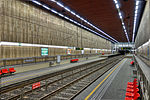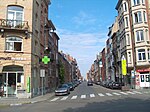Clockarium
2000 establishments in BelgiumArt Deco architecture in BelgiumHorological museumsHouses in BelgiumMuseums established in 2000 ... and 2 more
Museums in BrusselsSchaerbeek

The Clockarium is a museum in Schaerbeek, in the Brussels-Capital Region, Belgium, devoted to the Art Deco ceramic clock. It specializes into the faience mantel clocks, which were the first timepiece affordable to everyone and proudly decorating many homes in Belgium and Northern France during the 1920s and 1930s. It is located on the Reyers boulevard in a stylish Art-Deco house built in 1935 by Belgian architect Gustave Bossuyt.
Excerpt from the Wikipedia article Clockarium (License: CC BY-SA 3.0, Authors, Images).Clockarium
Boulevard Auguste Reyers - Auguste Reyerslaan,
Geographical coordinates (GPS) Address Nearby Places Show on map
Geographical coordinates (GPS)
| Latitude | Longitude |
|---|---|
| N 50.8484 ° | E 4.4022 ° |
Address
Boulevard Auguste Reyers - Auguste Reyerslaan 161
1030
Belgium
Open on Google Maps








